what can be added to barium to detect a radiolucent object
Clinical History:
A 45-year-old female patient presents afterwards hand trauma from a thorn bush. Fat-suppressed axial T2-weighted (1a), axial T1-weighted (1b), fat-suppressed sagittal T2-weighted (1c) and sagittal T1-weighted (1d) MR images are provided. What are the findings? What is your diagnosis?
 1a
1a
 1b
1b
 1c
1c
 1d
1d
 1e
1e
 1f
1f
 1g
1g
 1h
1h
An oblique anteroposteriorly oriented low signal intensity linear structure (arrows), consequent with a thorn foreign body, is present within the soft tissues overlying the dorsal distal radius at the level of Lister'southward tubercle. Surrounding edema is nowadays, with hemorrhagic or proteinaceous debris, manifest by a halo of surrounding increased T1 signal (Effigy 1b). The extensor tendons are intact and there is no osseous edema to suggest osteomyelitis. The morphology and signal characteristics of the structure, also every bit the absence of overt susceptibility artifact, are most suggestive of an embedded thorn given the provided history. A hypointense, non-anatomic focus surrounded past hyperintense material on T2-weighted sequences has been described every bit the "target sign", often seen with retained foreign bodies, as in this example (Figures 1a, 1c). one
Diagnosis:
Retained foreign body.
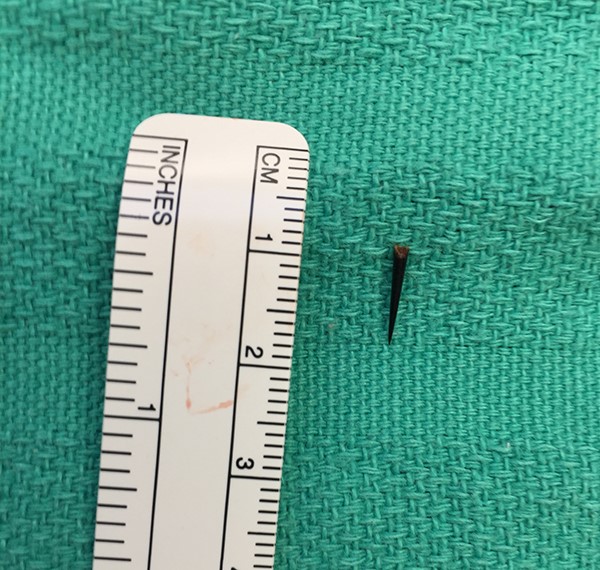
The thorn fragment was subsequently removed. Photo courtesy of Jennifer Chu, Physician (Orthopedic Associates of Dallas).
Introduction:
Embedded strange bodies are commonly encountered on imaging studies, peculiarly in the emergency department. The manner in which these inanimate objects find their way into the soft tissues tin can vary from trauma to self-embedding behavior.2 , 3 , iv Though the incident that resulted in the retained strange body is ofttimes known, it is not uncommon for the initial result to have been painless or the patient unaware at the time of trauma that a foreign body had cleaved the skin surface and become retained.3 With this in mind, close attention must be paid on all imaging studies to recognize non-anatomic structures, as well as acknowledge that an infectious of inflammatory processes could be secondary to an unsuspected strange trunk. Missing such a treatable procedure could result in significant consequences for the patient also as the radiologist.5 , 6
Confusion persists among ordering providers and radiologists which imaging modality is most appropriate for initial evaluation when a strange body is suspected.seven Another source of confusion is what types of strange bodies can be seen on conventional radiography, and what modality should be used if the radiographic exam is negative. As a outcome, the initial workup may exist incomplete, increasing the run a risk for a missed diagnosis.5 Complications can include vascular, tendinous or ligamentous injury as well every bit pronounced granulomatous reactions, sinus tract formation or abscess. ane, 6, 8 , ix , ten Additionally, migration of the foreign body over time has been described in the literature, which can effect in complications remote from the initial trauma.eleven
Foreign bodies can be loosely grouped into those that tin be seen on conventional radiography and those that cannot. The footing for this visibility centers on the atomic number and density of the construction, and its ability to attenuate the ten-ray beam. As a general dominion, the greater the atomic number and density, the amend it tin can be visualized.12 This would include objects such as graphite from a pencil, various metals, and stone, which are all denser than the surrounding soft tissues. A common misperception is that glass is radiolucent. Glass can be well visualized on conventional radiography, however its propensity to fragment into minute pieces can bear witness hard to place.7 Embedded wood and certain types of plastic are typically radiolucent and the just indication of their presence in the soft tissues may be its respective inflammatory response. 1,10, xiii
Radiographs stand for the initial study of pick when a foreign body is suspected, simply when the clinical suspicion is high and x-rays are negative, additional imaging modalities should exist considered.2 This is specially true when the foreign body may reside within bone, as college density structures may be missed in this setting.
If a radiolucent foreign body is suspected, ultrasound (US) may be useful for further evaluation.14 On ultrasound, strange bodies typically appear hyperechoic to surrounding tissue, oft with posterior shadowing which may described as "make clean" or "dirty" dependent on the surface characteristics of the strange torso.2 , fifteen , 16 , 17 Complications such as abscess formation, tendinous or vascular injury tin can besides be identified past this modality. A potential downfall of US is the inability to place a retained strange body that is surrounded past air, as well as identification of strange bodies embedded in os. Computed tomography (CT) can as well be utilized to diagnose retained strange bodies that are radiolucent such as forest and plastic. The presence of air interdigitating the porous construction of wood requires a broad window level to adequately visualize.fourteen Though CT can notice most foreign bodies and provide improve geographic detail of their exact location, information technology is less well suited to determine the degree of inflammation or associated damage to structures such equally ligaments or tendons than MRI.2
The aim of this web dispensary is to explore the imaging characteristics of foreign bodies on MRI. Without a guiding history, foreign bodies have the potential to be overlooked by the unsuspecting radiologist. Additionally, the sequelae of a chronically retained foreign body could be attributed to a more than sinister procedure such as malignancy, resulting in unnecessary stress and treatment for the patient.vi Nosotros will discuss the physics behind the artifact induced by some foreign bodies, and how sequence conquering can be optimized to reduce artifacts, or in some cases even increase artifacts to meliorate foreign body detection. Lastly, we will explore dedicated metallic-antiquity reduction techniques when imaging for complications of prior surgery, such as hardware loosening, osteolysis or recurrent tendon tears.
Susceptibility Artifact
A well-known manifestation of embedded foreign bodies is the induction of susceptibility artifact. In many circumstances, this tin limit study usefulness due to obscuration of regional soft tissues secondary to indicate void and geometric baloney eighteen; still, it tin also be used to our advantage to appreciate the presence of a foreign body that is likewise small to be seen on conventional imaging. In guild to gain an understanding of the diverse imaging manifestations of susceptibility artifact, it is necessary to explore how information technology is created.
Susceptibility artifact results from magnetic field inhomogeneities, and magnetic susceptibility is divers as the degree a substance can affect relative magnetic field strength as a fraction of the magnetic field in which it is independent.19 Different tissues and substances within the human trunk induce local magnetic fields, which can either subtract from or add together to relative magnetic field strength. Past definition, paramagnetic substances contribute to magnetic field strength by aligning in the management of the chief magnetic field, while diamagnetic substance reduce magnetic field force by adjustment opposite to this field.20 We know that the precessional frequencies of protons, as described past the Larmor equation, are dependent on the strength of the magnetic field. A outcome of this relationship is variation in precessional frequencies of adjacent protons when variable relative magnetic fields are induced by different substances. Variation in precessional frequencies portends greater dephasing and signal loss, as well every bit mis-mapping of signal causing geometric distortion and signal pile-up.18 Additionally, pregnant frequency variations tin hinder chemical fat suppression.21 Consequently, susceptibility artifacts induced by certain foreign bodies are increased when a higher field strength magnet is used, which results in even greater discrepancies in regional precessional frequencies.18 Without the use of refocusing radiofrequency (RF) pulses used in spin-echo sequences, this inhomogeneity tin issue in dephasing and accelerated signal decay. By understanding how a substance affects relative magnetic field forcefulness, we tin predict the degree of susceptibility artifact that it will induce.
Substances that are diamagnetic have paired electrons that tin weaken the regional magnetic field. Examples of such substances are water, which has a diamagnetism of nearly zero, besides as normal tissues such as muscle and fat. Within the human trunk, calcium acts as the most pronounced naturally occurring diamagnetic substance. Conversely, paramagnetic materials take unpaired electrons that event in superlative of the regional magnetic field and acceleration of T1 and T2 relaxation times. An instance of such a substance is the imaging contrast gadolinium, which in the appropriate concentration tin can shorten T1 relaxation fourth dimension and produce high signal intensity useful for distinguishing pathology.22 An boosted paramagnetic substance is air, which accounts for the limited usefulness of MRI when examining the face and sinuses. On the far end of the spectrum are ferromagnetic materials, such as iron or nickel, which have farthermost positive magnetic susceptibility secondary to aggregation of unpaired electrons in a configuration that can result in profound indicate loss.xix
An important issue of magnetic susceptibility is its upshot on transverse relaxation time and resultant T2 betoken. When measurement of T2 signal is influenced by both the natural T2 of the tissue in concert with the influence of magnetic field inhomogeneities, information technology is referred to every bit T2* (T2 star). If tissue heterogeneity results in relaxation times faster than the intrinsic T2, then the imaging advent is more sensitive to the effects of magnetic susceptibility. To counteract this, spin-repeat techniques with their 180° refocusing pulse were created to assistance negate the effects of magnetic field inhomogeneity. Conversely, gradient-repeat sequences allow for dephasing of spinning protons secondary to T2* decay and therefore are more susceptible to artifact from field inhomogeneities such as metallic strange bodies and surgical material.
Blooming artifact represents a manifestation of susceptibility antiquity where an object or lesion appears larger than its true size. The more susceptibility artifact, the more pronounced the distortion. Equally ane could infer, gradient-echo sequences are more sensitive to this antiquity when strongly diamagnetic, paramagnetic, superparamagnetic, or ferromagnetic structures are present when compared to spin-echo sequences. Many sequences, such as susceptibility weighted imaging, accept advantage of this artifact to assistance place blood products or calcium. Despite the effectiveness of spin-echo sequences, strongly magnetic foci in soft tissues will still upshot in susceptibility artifact, especially when the TE is increased.
Example 2
A 35-year-one-time female patient presents afterwards trauma to the volar aspect of the wrist from a pencil. Presented beneath are: Frontal and Lateral wrist radiographs (2a, b), Coronal T1-weighted (2c), Coronal proton density-weighted with fat saturation (FS) (2d), Axial proton density-weighted FS (2e) Axial T1-weighted (2f) and Sagittal T2-weighted (2g) MRI images are provided.
 2a
2a
 2b
2b
 2c
2c
 2d
2d
 2e
2e
 2f
2f
 2g
2g
On the x-rays, no foreign torso is seen. Further evaluation with MR reveals a region of indicate void and slight blooming artifact (arrows) along the volar aspect of the wrist, superficial to the carpal tunnel. Edema surrounds the foreign torso on T2-weighted sequences, which extends towards the intact transverse carpal ligament (2e).
As discussed to a higher place, susceptibility and blooming artifact are a upshot of magnetic field inhomogeneities which alter precessional frequencies of protons and can outcome in geometric distortion and regions of signal void. 23 Depending on the severity of the antiquity, blooming has the potential to obscure close evaluation of next soft tissues. We see in this case the degree of blooming artifact is more pronounced on the proton density-weighted sequences relative to T1-weighted sequences, with the size of the signal void closer to its bodily size on the T1-weighted images. This is due to the longer TE required to obtain proton density-weighted images. It is suspected in this case that a component of the blooming antiquity may exist related to the presence of air (which is paramagnetic), considering graphite is diamagnetic and tin can even exist used every bit a shimming cloth to help correct magnetic field inhomogeneities.24
Case 3
This patient stepped on a piece of metal. Sagittal STIR (3a), Sagittal T1-weighted (3b), Coronal proton density-weighted FS (3c), and Axial T2-weighted (3d) MRI images are provided.
 3a
3a
 3b
3b
 3c
3c
 3d
3d
The MRI reveals a region of susceptibility and blooming antiquity (arrows) located within the plantar superficial soft tissues overlying the calcaneus. Equally expected, the degree of blooming is nigh pronounced on longer TE sequences (3a has a TE of 46 ms). It is important to note once more that air is a paramagnetic substance that tin induce susceptibility antiquity, so the presence of such an artifact in a region of recent trauma does not definitively correspond a retained foreign trunk. This advent can also be seen at a site of prior surgery due to air and metal particles from tissue cauterization or use of a burr.25 Though hard, the radiologist must endeavor to "see through the artifact" and evaluate for complications such as tendinous injury.
Case 4
This patient presented after a shotgun injury to the articulatio genus, readily apparent on the lateral radiograph (4a).
 4a
4a
 4b
4b
 4c
4c
Gradient-echo imaging of the knee in the sagittal plane (4b) reveals a distorted focus of slight blooming artifact approaching, only not disrupting, the posterior oblique ligament. A more accurate representation of the truthful size of the strange body is seen on the T1-weighted epitome (4c). Given the fact that shotgun pellets are classically composed of lead (a diamagnetic material), this accounts for the minimal amount of susceptibility artifact appreciated even on the slope-echo sequence. A ferromagnetic structure would be expected to more significantly hinder regional soft tissue discrimination.
Instance 5
The 47-yr-old male patient in case 5 presented after trauma to the hand with a metallic foreign body seen on conventional radiography (5a).
 5a
5a
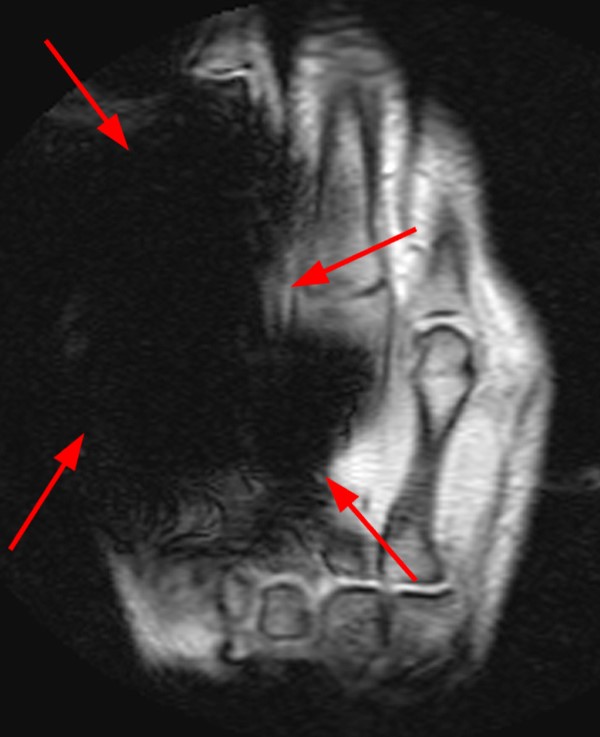 5b
5b
 5c
5c
 5d
5d
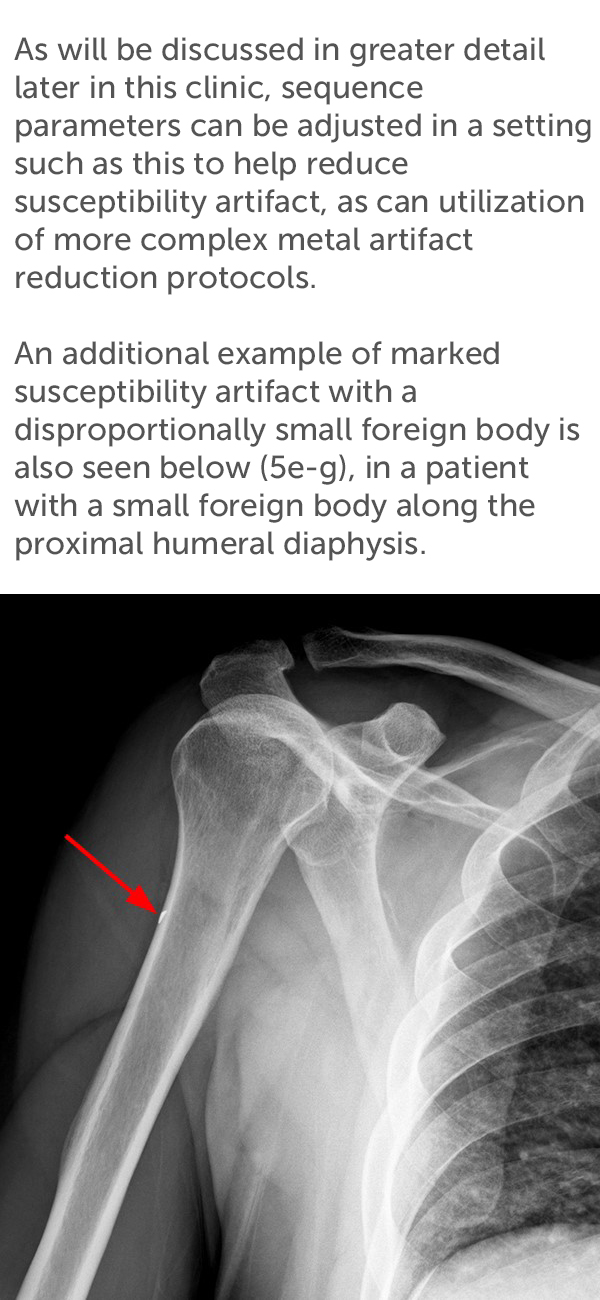 5e
5e
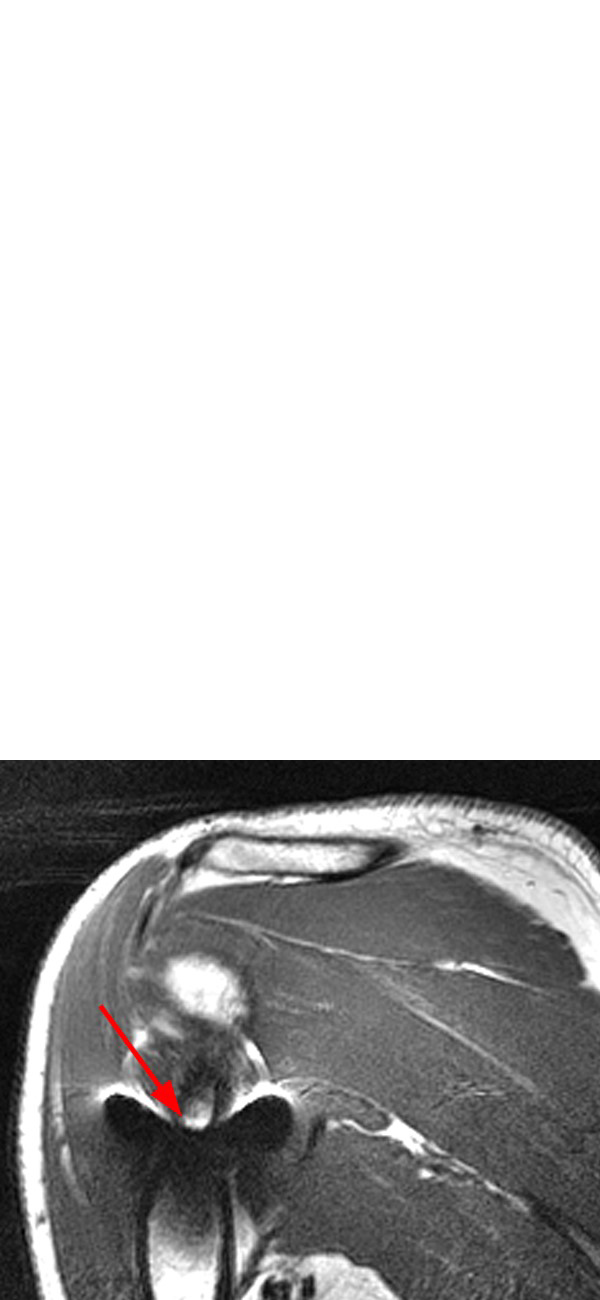 5f
5f
 5g
5g
MR imaging was obtained which was degraded by severe susceptibility artifact and geometric distortion despite the relatively small size of the embedded foreign body. The degree of antiquity is more pronounced on the gradient echo localizer (5b) and STIR (5c) images. The T1-weighted image (5d) is more than useful to show a relative decrease in susceptibility antiquity and blooming.
Complications of Retained Foreign Bodies
Identification of retained foreign bodies on MRI can prove exceedingly difficult when the object does not issue in meaning magnetic field inhomogeneity and resultant susceptibility antiquity. Examples of such objects are glass, woods and plastic. When these substances are suspected to be retained within the torso, information technology is imperative to look closely for structures that exhibit a non-anatomic advent and orientation. Such objects may exhibit straight edges or produce correct angles. Strange bodies are typically seen on MRI equally hypointense on both T1 and T2-weighted sequences or every bit a region of point void mimicking tendinous or ligamentous structures.2 It is imperative to evaluate for symmetry and to look closely for these betoken characteristics in superficial soft tissues where structures such as ligaments, tendons or prominent vascular structures would not typically exist seen.
In many instances, the ordering physician, as well equally the patient, may be unaware that a foreign body is nowadays. The clinical findings that may pb to obtaining an MRI include a soft tissue mass, draining wound or sinus, or merely regional erythema. An unsuspecting radiologist could then overlook a strange trunk and advise a more than concerning process such as a neoplasm. A suggestion such as this could result in unnecessary stress and surgical/medical intervention for the patient.5,vi Existence enlightened of the complications of acute or chronic foreign bodies, such as foreign body granuloma, abscess, draining sinus tract, osteomyelitis or solid/cystic mass should help the radiologist to consider the correct diagnosis.
Example 6
The patient below presented afterwards trauma to the manus while handling forest, with clinical suspicion for a retained splinter. MR imaging of the hand was performed before and subsequently intravenous gadolinium.
 6a
6a
 6b
6b
 6c
6c
 6d
6d
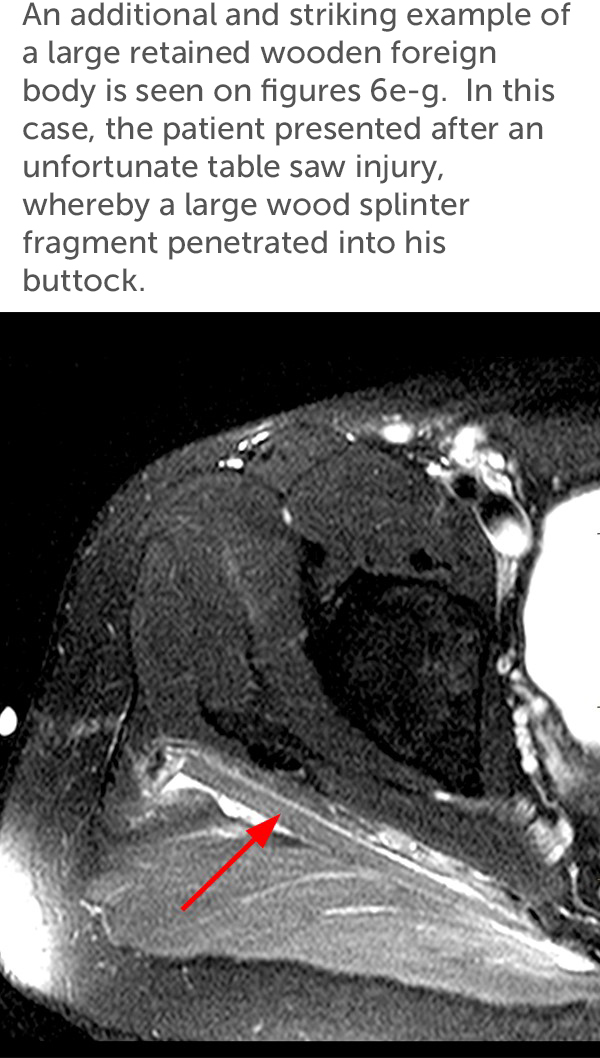 6e
6e
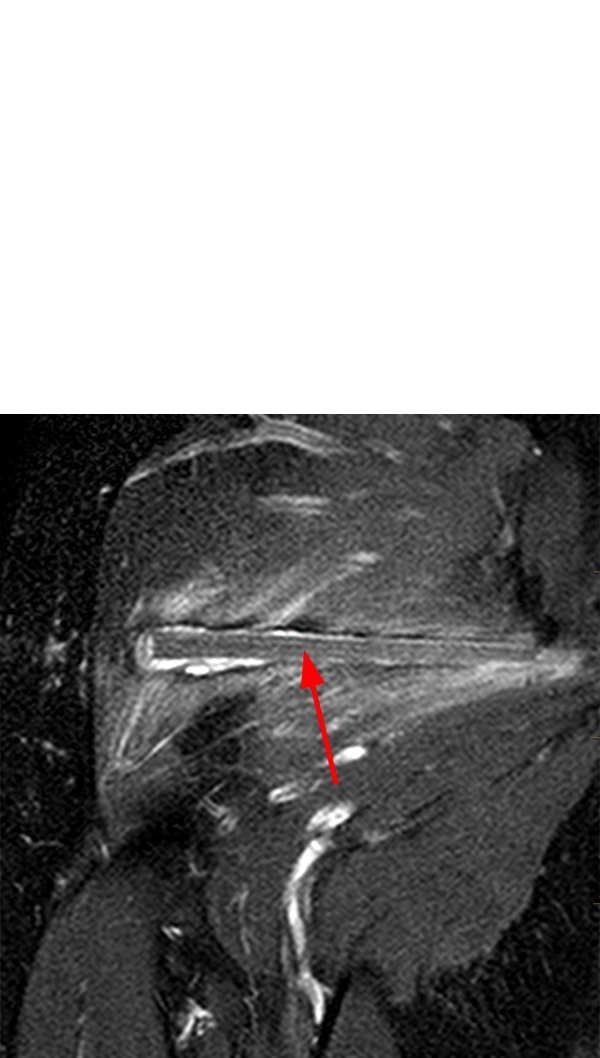 6f
6f
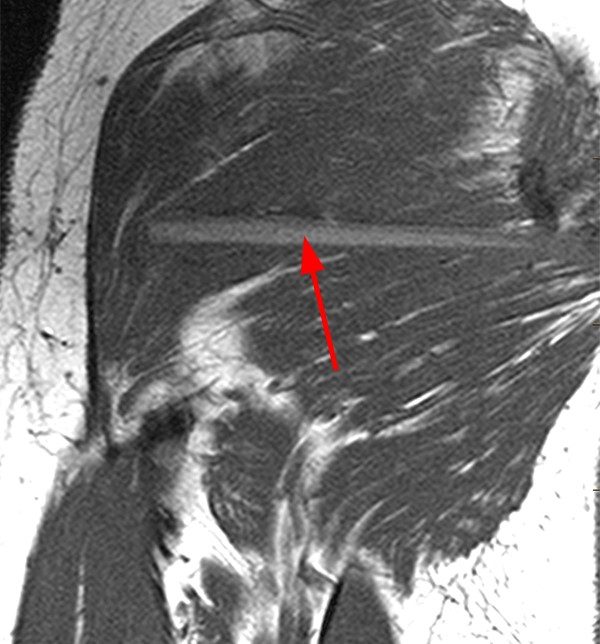 6g
6g
Clearly identified is a large, triangular-shaped, T1 and T2 hypointense splinter embedded in the palmar aspect of the hand, extending from the first webspace into the flexor digitorum brevis and adductor pollicis muscles. Increased T2 signal (6a) and contrast enhancement (6b) surround the splinter uniform with granulation tissue. A pocket of increased T2 indicate (6c) and rim enhancement (6d) within the next spider web space is consistent with an next abscess. On the axial paradigm, the strange torso could be confused with a tendon, given its low signal and like class equally the adjacent flexor tendons. The secondary findings and multiplanar benefits of MRI mitigate any defoliation.
The T2 weighted images (6e, 6f) reveal an intermediate bespeak intensity linear structure embedded in the deep aspect of the gluteus maximus muscle with surrounding edema. The T1-weighted paradigm (6g) shows the foreign body to be hyperintense to muscle. Of note, because of the porous nature of wood, the classic T1 and T2 hypointense bespeak commonly seen with foreign bodies may exist absent due to interdigitation of hemorrhage and fluid. This is more common with larger wooden fragments.
Instance 7
The patient beneath presented with pain and swelling along the dorsal-ulnar attribute of the hand.
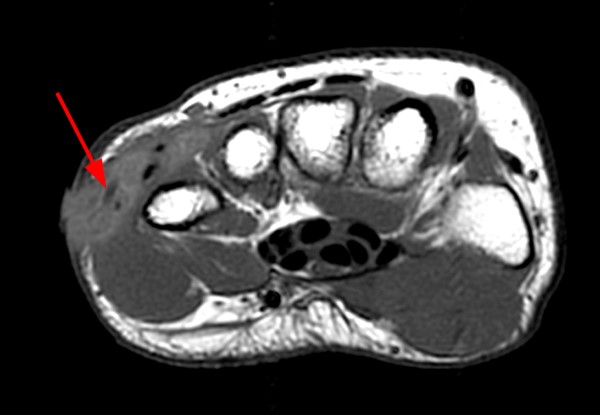 7a
7a
 7b
7b
 7c
7c
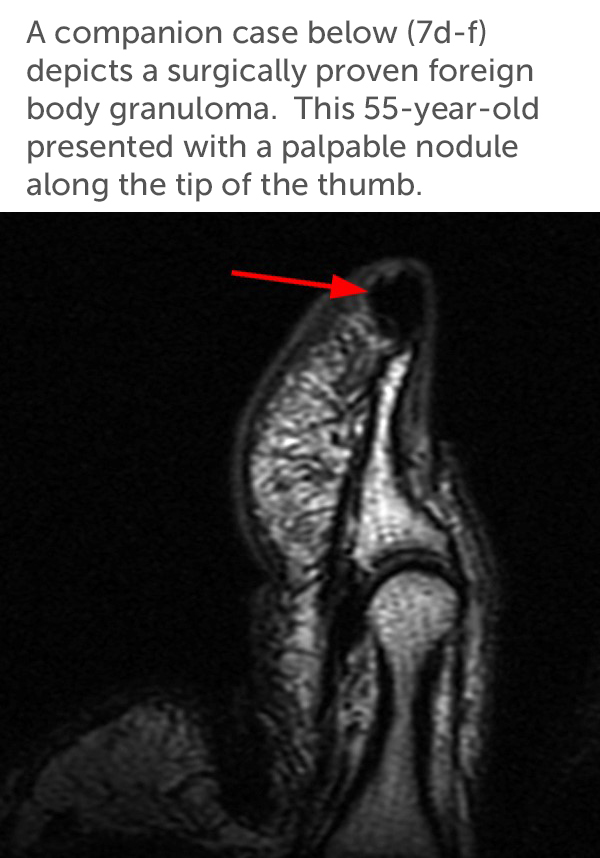 7d
7d
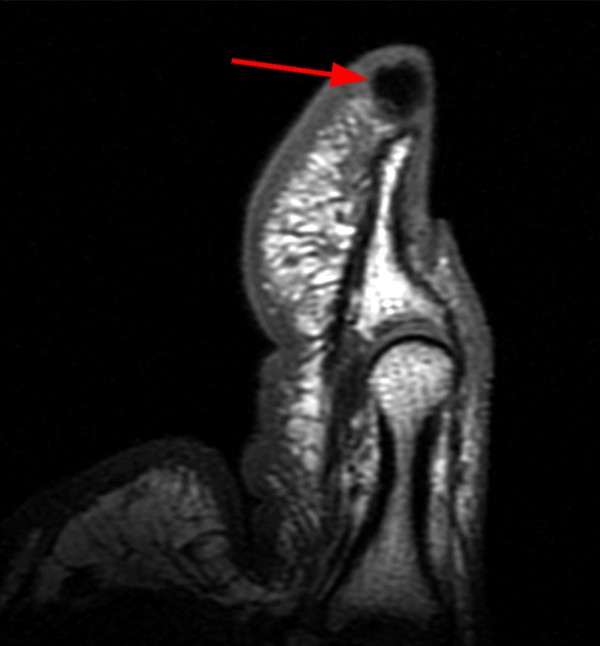 7e
7e
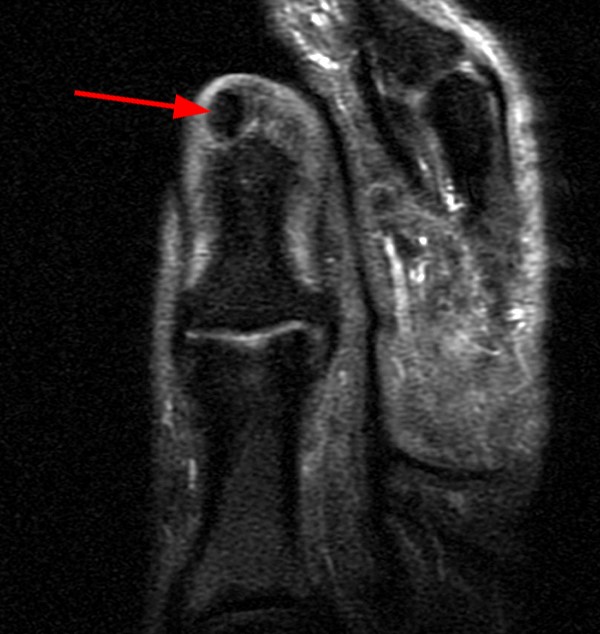 7f
7f
MR imaging reveals a T1 and T2 hypointense focus in the region of swelling concerning for a foreign torso (arrows). No significant susceptibility artifact is identified. The T1-weighted prototype (7a) reveals surrounding hyperintense indicate within the soft tissues compatible with hemorrhage. Increased T2 signal is likewise present (7b). The surrounding tissue as well centrally enhances with Iv contrast (7c), consistent with granulation tissue or developing strange body granuloma. The osseous and adjacent tendinous structures appear normal.
MR imaging reveals a T1 and T2 hypointense focus corresponding to the concrete exam findings. On the T2-weighted paradigm (7d), the structure exhibits slight blooming artifact, with the lesion smaller on the shorter TE/T1-weighted paradigm (7e). No enhancement or regional edema is seen. Subsequently surgical excision and pathologic evaluation, a punctate foreign body was found surrounded past a calcified foreign body granuloma. The presence of blooming artifact is attributed to the significant diamagnetism exhibited by calcium.
Case eight
The 34-year-quondam male patient below presented after trauma to the hand with a wooden object.
 8a
8a
 8b
8b
 8c
8c
 8d
8d
MR imaging repeals a T1 mildly low signal (8b) and T2 low betoken intensity (8a), foreign trunk running obliquely within the second intermetacarpal interspace. Increased point is present on both T1 and T2-weighted sequences surrounding the foreign body compatible with hemorrhage and edema. Surrounding inflammation and myositis are present. Increased T2 signal within the adjacent 3rd metacarpal (8c), is concerning for superimposed osteomyelitis. An overlying abscess is noted in within the more superficial dorsal soft tissues adjacent to a surface marking (8d).
Instance 9
Radiography of this 35-yr-one-time male person'south wrist revealed a circumscribed geographic lytic lesion inside the distal radius, with surrounding sclerosis, cortical thickening and periostitis. These findings are most apropos for an infectious process with a neoplastic lesion such as a giant prison cell tumor considered less likely. Farther label with MRI was performed.
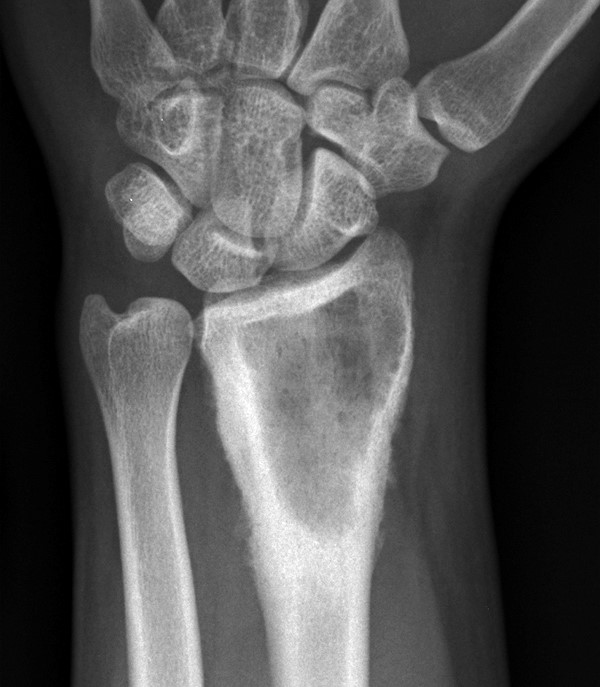 9a
9a
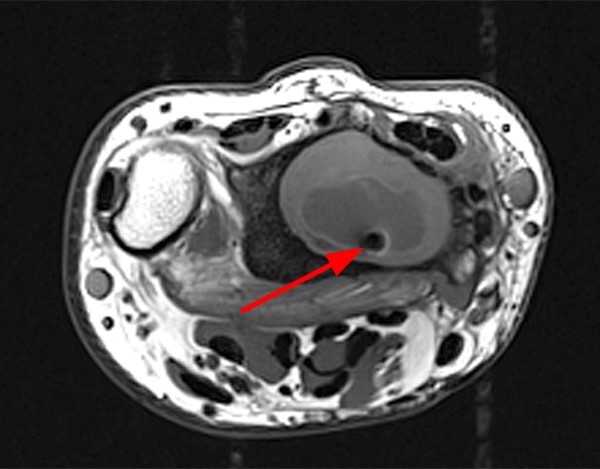 9b
9b
 9c
9c
 9d
9d
 9e
9e
The lytic surface area contains increased T1 signal (9b), increased T2 betoken (9c), and central non-enhancement on post-contrast imaging (9d), consistent with an intra-osseous hematoma and abscess, surrounded by granulation tissue. Within the abscess lies a small T1/T2 hypointense focus with mild susceptibility artifact, consistent with a foreign body (arrows). Surgical intervention revealed the strange body to be graphite from a pencil, which accounts for its only mild susceptibility.
MR Imaging for Complications of Surgery
In a patient with a surgically-implanted foreign torso, MRI becomes more challenging but remains highly useful in evaluating for complications 25 , 26 , 27 Despite its ability to provide excellent contrast resolution, MRI tin can be hindered past artifact secondary to metallic implants, screws, staples and metallic shavings. Depending on the metallic composition of the orthopedic hardware, the degree of susceptibility artifact may render the MRI nondiagnostic.28 Notwithstanding, with optimization of sequence parameters and utilization of novel techniques designed specifically for metallic artifact reduction, MRI is at present the modality of option when previously its usefulness was limited.26
Example x
The patient in case ten initially presented for shoulder radiographs with clinical concern for complications of a rotator cuff repair.
 10a
10a
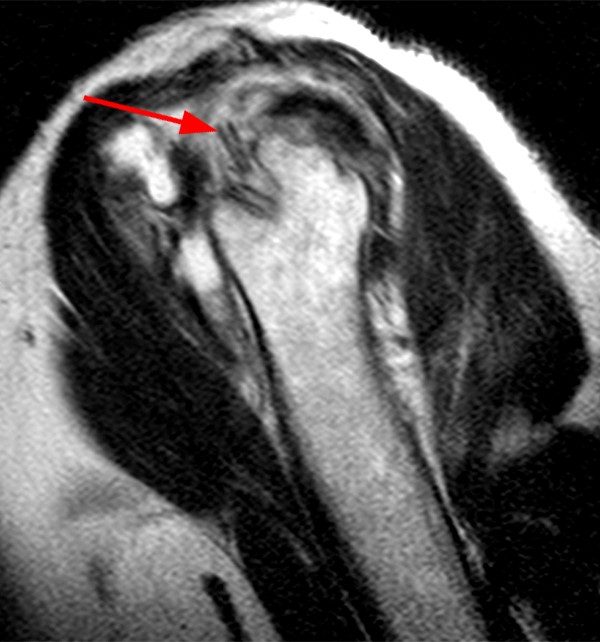 10b
10b
 10c
10c
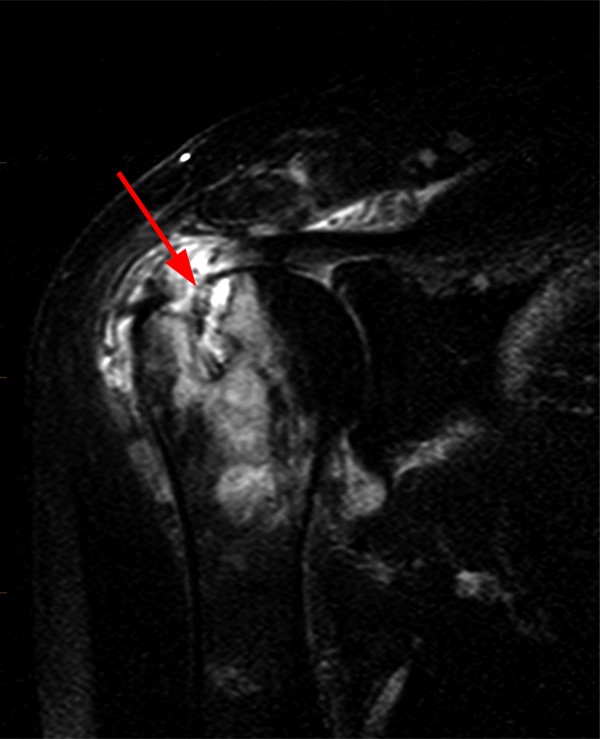 10d
10d
The AP shoulder radiograph (10a) reveals osteolysis with cortical destruction of the posterolateral humeral head at the greater tuberosity. The sagittal T2-weighted image (10b) reveals malposition of a suture ballast, dislodged from its original location. Coronal T1-weighted (10b) and T2-weighted fatty-suppressed images (10c) reveal osteolysis surrounding the anchor, with marked surrounding osseous edema (concerning for osteomyelitis), and overlying subacromial/subdeltoid bursitis.
Case xi
The patient below had undergone a remote silicone implant of the radial head and presented with worsening pain.
 11a
11a
 11b
11b
 11c
11c
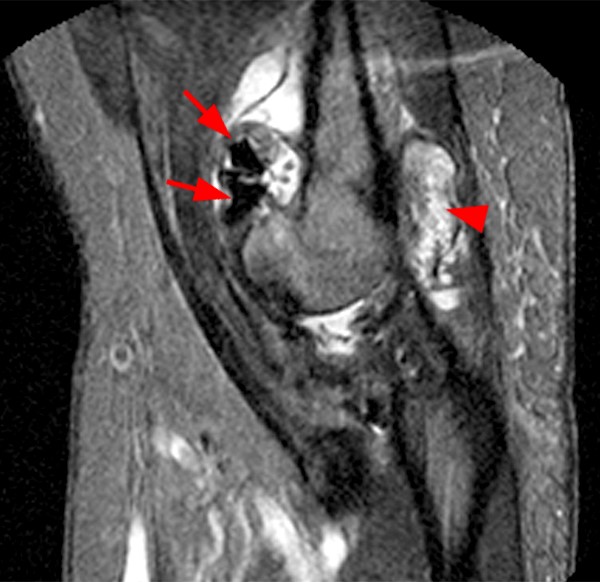 11d
11d
Coronal proton density-weighted (11a) and multiplanar STIR (11b-d) images demonstrate a fragmented displaced radial head implant (arrows), and frond-like synovial hypertrophy consistent with silicone synovitis (arrowheads).
MR Imaging Optimization with Known Metal
If a metallic foreign body is discovered to create problematic artifacts, techniques can be employed to subtract the artifact. To understand the metal optimization techniques, information technology is first helpful to further ascertain the problematic artifacts:
In-plane distortions are a broad category of artifacts resulting from signal loss and pileup due to distortions of the local field homogeneity by the ferromagnetic foreign body. This manifests equally a cloud of signal loss surrounding the body, due to T2* dephasing. This artifact is about obvious on gradient-repeat sequences, which lack a refocusing pulse.29 Variable precessional frequencies induced by magnetic field inhomogeneity cause mis-registration of signal on the final image20, which accounts for the rim of increased signal surrounding the foreign body (bespeak pile-up).18 These artifacts tend to be less pronounced when the longest portion of the prosthesis/foreign body is aligned parallel to the B0 field.
Poor fatty suppression too results from the local field variations from the ferromagnetic foreign body. These are most pronounced with chemical (spectral) fat-suppression techniques, which rely on homogeneous local fields to differentiate the relatively small differences in the chemical shifts betwixt fatty and water.
Geometric distortion is akin to chemic shift artifact, whereby the presence of both the foreign body (eastward.g. metallic alloy implant) and human tissue are averaged together within the same voxel, creating image distortion by spreading pixels over a wider range.
Through-plane (slice-to-piece) distortion are artifacts that extend across MR slice boundaries, and are dependent on the slices thickness and resolution utilized. Through-plane distortion occurs during slice-selective excitation due to non-linear signal mapping induced by magnetic field inhomogeneities.27
Cardinal MR prototype optimization techniques in a patient with metal are generically called MARS (Metal Artifact Reduction Sequences) techniques. Newer more advanced proprietary techniques such as multi-conquering with variable-resonance image combination, (MAVRIC-GE) and piece encoding for metallic artifact correction (SIEMAC -Siemens) are besides available. MARS sequences are non vendor specific and are simply strategies for dealing with the artifacts:
Slope-echo sequences should exist avoided when metallic hardware is present.22 The use of fast-spin echo (FSE) is much more than advantageous in decreasing in-airplane distortion, due to its 180° refocusing pulse which limits the degree of intravoxel dephasing and resultant betoken loss.29
Chemical fat-saturation should be avoided. If fluid-sensitive images are desired, STIR (brusque-tau inversion recovery) will result in more homogeneous fatty-supression22.
Frequency-encoding direction should be adjusted relative to the orientation of the patient's hardware. 18,26 Local magnetic field inhomogeneities induced by hardware result in phase and frequency changes causing mis-registration of indicate. Resultantly, hardware artifact is worse along the frequency-encoding direction. It is therefore beneficial to recognize the orientation of hardware and suit the frequency and phase-encoding centrality accordingly.eighteen This proves hard in the setting of full shoulder arthroplasty due to the hemispheric configuration of the prosthesis.22
Wider receiver bandwidth should be utilized, every bit sampling a wider range of frequencies will decrease the geometric distortion.25,26,29 Additionally, a shorter echo time will allow for less dephasing and subsequent signal loss.29
Through-airplane distortions can exist improved by altering parameters which subtract voxel size. These can be accomplished by using a decreased of field of view (FOV), thinner slices, and higher matrix resolution.eighteen,25,26
Decreased interecho spacing through the apply of longer echo train lengths (ETL) has also been shown to subtract metal artifacts.18 , 22
Considering many of the above techniques (increased bandwidth, smaller FOV, thinner slices, higher matrix) issue in a driblet in the signal-to-noise ratio (SNR), it is useful to increase the number of excitations/averages (NEX/AVG). Unfortunately, this likewise results in longer imaging times.
It'due south likewise of import to retrieve the caste of susceptibility artifact increases with MRI field strength; therefore metal artifacts are lower at 1.5T compared with 3T scanners.
Example 12
The patient beneath has undergone a rotator cuff repair, and a suture ballast is noted within the greater tuberosity during a fluoroscopic arthrogram injection image (12a).
 12a
12a
 12b
12b
 12c
12c
 12d
12d
 12e
12e
Initial T2-weighted MR images with chemical fat saturation and typical receiver bandwidth (12b, 12d) demonstrate extensive metal antiquity from the suture anchor (in-airplane distortion, poor fat-suppression, and geometric baloney), rendering the study almost non-diagnostic. Additional sequences were performed with MARS techniques (removed chemical fatty-saturation, increased receiver bandwidth, higher resolution, decreased TE, increased ETL, increased NEX), which significantly decreased the metallic artifact (12c, 12e).
It is important to recognize that magnetic field inhomogeneities induced past ferromagnetic implants often render chemical fatty suppression techniques of trivial benefit. Chemic fat suppression takes advantage of the chemical shift between fat and water, where fat is known to resonate at a frequency approximately 220 Hz less that water (at one.5 T). A narrow bandwidth RF pulse is administered close to that of fatty followed past a spoiling gradient to null its signal. 30 When a metal object is present, there is a shift in resonant frequency induced by local magnetic field inhomogeneity which hinders the ability to selectively excite fat. This upshot, in addition to the wider bandwidth needed to reduce metallic antiquity, renders chemic fat suppression most useless in the presence of a ferromagnetic object. When fatty suppression is required, short inversion time inversion-recovery (STIR) sequences should exist used. This technique does not rely on chemical shift, only instead relies on the shorter T1 relaxation fourth dimension of fat relative to water.20,21 An inference one can make based on the mechanism of STIR fat suppression is its limited use when the test is performed with contrast. The nulling RF pulse used to suppress fat betoken would also null the signal induced by the T1 shortening consequence of gadolinium.21
Summary
Recognition of embedded strange bodies is possible utilizing various imaging modalities, with conventional radiography considered the initial examination of option. MRI is typically reserved to narrate complications the foreign body might elicit. This includes, merely is not limited to, abscesses, osteomyelitis, granulomas, adverse tissue reactions, also as injury to vascular, tendinous or ligamentous structures. Being aware of these manifestations will assistance the observer look more closely for a foreign body, which tin ofttimes be difficult to identify on MRI. An understanding of how sure foreign bodies tin can effect in magnetic field inhomogeneities will allow for amend identification and characterization of the embedded object. Additionally, a audio knowledge of the physics associated with strange body imaging volition let the radiologist to tailor sequence acquisitions to reduce, or peradventure fifty-fifty enhance, associated antiquity and aid in accurate diagnoses.
References
pearsoncauseveras1954.blogspot.com
Source: https://radsource.us/foreign-body-imaging-mri/
0 Response to "what can be added to barium to detect a radiolucent object"
Post a Comment